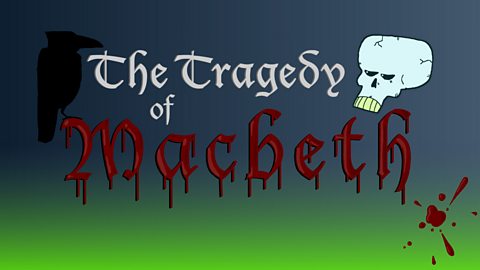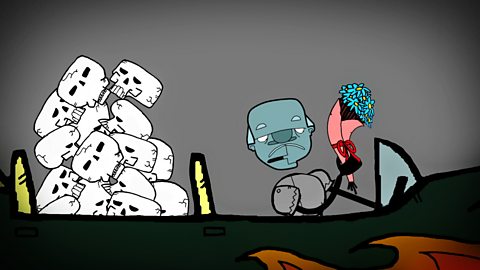Language overview
The way we write and speak has changed a lot over the past 400 years since Shakespeare wrote his plays, so don’t be put off if you find Shakespeare’s words difficult.
Shakespeare used the following aspects of language in Macbeth to grip and terrify his audience:
- rhythm and rhyme
- imagery and metaphor
Rhythm and rhyme
Shakespeare used rhythm and rhyme in his plays for many different purposes. A strong rhythm gives the language energy. Rhythm also makes the words easier for actors to memorise. Rhythm and rhyme is used to distinguish between certain types of characters. Changes in rhythm and rhyme highlight certain things about tone and mood.
Question
Why do the Witches always speak in rhyme?
Ordinary people don’t go about speaking in rhyme. The Witches aren’t ordinary people. Hearing the Witches speak in rhyme reminds us that they are not normal human beings.
Just before Macbeth enters the cavern, the second Witch says:
SECOND WITCH
By the pricking of my thumbs,
Something wicked this way comes
Act 4 Scene 1
Question
Why does Shakespeare often end a dramatic scene with a rhyming coupletA pair of lines that rhyme.?
A rhyming couplet at the end of a scene signifies to the audience that the scene is about to change. This particular couplet has power as it sets up our expectations for what is to come. It’s like the drum beat at the end of an episode of EastEnders.
Macbeth ends with:
MACBETH
It is concluded. Banquo, thy soul's flight,
If it find heaven, must find it out tonight.
Act 3 Scene 1
Question
The Porter is neither royal, noble, or otherworldly - how is this reflected in his speech?
The Porter’s speeches are unrhymed and conversational and so the rhythm reflects normal speech. He speaks directly to the audience at first and there is a definite change of tone to provide light relief after the murder. His speech has a lively and engaging rhythm along with repetition to enhance the humorous content.
The Porter begins a succession of jokes about who might be at the door:
PORTER
Knock, knock! Who’s there…
Act 2 Scene 3
Question
What method does Shakespeare use to slow down the pace of Macbeth’s speech and create a tone of regret?
He uses repetition.
When Macbeth learns that his wife has died, he says:
MACBETH
Tomorrow, and tomorrow, and tomorrow
Creeps in this petty pace from day to day.
Act 5 Scene 5
Listening task
FIRST WITCH
Thrice the brindled cat hath mewed.
SECOND WITCH
Thrice and once the hedge-pig whined.
THIRD WITCH
Harpier cries, '’Tis time, 'tis time.’
FIRST WITCH
Round about the cauldron go;
In the poisoned entrails throw.
Toad, that under cold stone
Days and nights has thirty-one
Sweltered venom sleeping got,
Boil thou first i'th’charmèd pot.
ALL
Double, double toil and trouble;
Fire burn, and cauldron bubble.
SECOND WITCH
Fillet of a fenny snake,
In the cauldron boil and bake:
Eye of newt, and toe of frog,
Wool of bat, and tongue of dog,
Adder's fork, and blind-worm's sting,
Lizard's leg, and howlet's wing,
For a charm of powerful trouble,
Like a hell-broth, boil and bubble.
ALL
Double, double toil and trouble,
Fire burn and cauldron bubble.
THIRD WITCH
Scale of dragon, tooth of wolf,
Witches' mummy, maw and gulf
Of the ravined salt-sea shark,
Root of hemlock, digged i'th’dark;
Liver of blaspheming Jew,
Gall of goat, and slips of yew,
Silvered in the moon's eclipse;
Nose of Turk, and Tartar's lips,
Finger of birth-strangled babe,
Ditch-delivered by a drab,
Make the gruel thick and slab.
Add thereto a tiger's chaudron
For th’ingredients of our cauldron
ALL
Double, double toil and trouble,
Fire burn, and cauldron bubble.
SECOND WITCH
Cool it with a baboon's blood,
Then the charm is firm and good.
Question
Can you list some of the disgusting things that are thrown into the cauldron?
Here are just a few of them:
- some entrails
- one toad
- fenny snake fillet
- one newt’s eye
- one frog’s toe
- bat fur
- dog’s tongue
Question
What lines do the Witches repeat as a kind of chorus?
WITCHES
Double, double toil and trouble,
Fire burn, and cauldron bubble.
Act 4 Scene 1
Imagery and metaphor
Metaphors are detailed comparisons that make writing and speech come alive in our imaginations. On Shakespeare’s stage there were no special effects, the stage was pretty bare except for actors, and the props were few and far between. The writing had to paint exciting scenes in the audience’s minds. This is imagery.
Analysis of imagery and metaphor in the play
Question
What imagery does Lady Macbeth use to advise Macbeth?
Lady Macbeth tells him to:
LADY MACBETH
Look like th’ innocent flower, But be the serpent under’t.
Act 1 Scene 5
By using this flower and snake imagery she’s advising Macbeth to make everyone think he’s innocent and gentle, whilst he’s being evil like a snake underneath it all.
Question
What does Macbeth compare his ambition to?
Macbeth compares his ambition to a galloping race horse.
He says:
MACBETH
I have no spur to prick the sides of my intent, but only vaulting ambition
Act 1 Scene 7
This is a horse riding metaphor. Ambition makes him use the spurs to speed towards his prize - the crown.
Question
Shakespeare uses vivid imagery to describe Donalbain’s vulnerability. How does he do this?
Donalbain is suspicious of everyone around him and realises that he and his brother are vulnerable. On hearing that their father, King Duncan has been murdered, Donalbain tells his brother:
DONALBAIN
There’s daggers in men’s smiles
Act 2 Scene 3
Donalbain isn’t describing men with knives in their mouths. He’s talking about the danger he and his brother are in, especially from the people who are pretending to be their friends.
Question
How does Macbeth create a sense of sadness for the audience when Lady Macbeth dies?
Macbeth compares his wife’s life to the flame of a candle. He says:
MACBETH
Out, out, brief candle
Act 5 Scene 5
He knows that she died too young - like a candle being snuffed out too quickly.
Listening task
LADY MACBETH
The raven himself is hoarse
That croaks the fatal entrance of Duncan
Under my battlements (the tops of the walls of the castle). Come, you spirits
That tend on mortal thoughts, unsex me here
And fill me from the crown to the toe topfull
Of direst cruelty; make thick my blood,
Stop up th’access and passage to remorse
That no compunctious visitings of nature
Shake my fell purpose nor keep peace between
Th’effect and it. Come to my woman's breasts
And take my milk for gall, you murd’ring ministers,
Wherever in your sightless substances
You wait on nature's mischief. Come, thick night,
And pall thee in the dunnest smoke of hell,
That my keen knife see not the wound it makes,
Nor heaven peep through the blanket of the dark,
To cry, 'Hold, hold.'
In Act 1 Scene 5, Lady Macbeth calls upon evil spirits to make her more like a man so that she can commit her horrible deeds successfully. Her speech sounds a lot like a spell. This gives the audience an understanding that Lady Macbeth is more than an ambitious woman. She’s an unnatural subhuman creature of the night.
Question
Which words relate to death and darkness?
- Raven (a big black ugly-looking bird, often seen as an omen for death)
- Fatal (leading to death)
- Murdering ministers (evil spirits that Lady Macbeth believes will help her to commit murder)
- Thick night (pitch blackness)
- Pall (a cover for a coffin)
- Smoke
- Hell
More on Macbeth
Find out more by working through a topic
- count5 of 5

- count1 of 5

- count2 of 5

- count3 of 5
